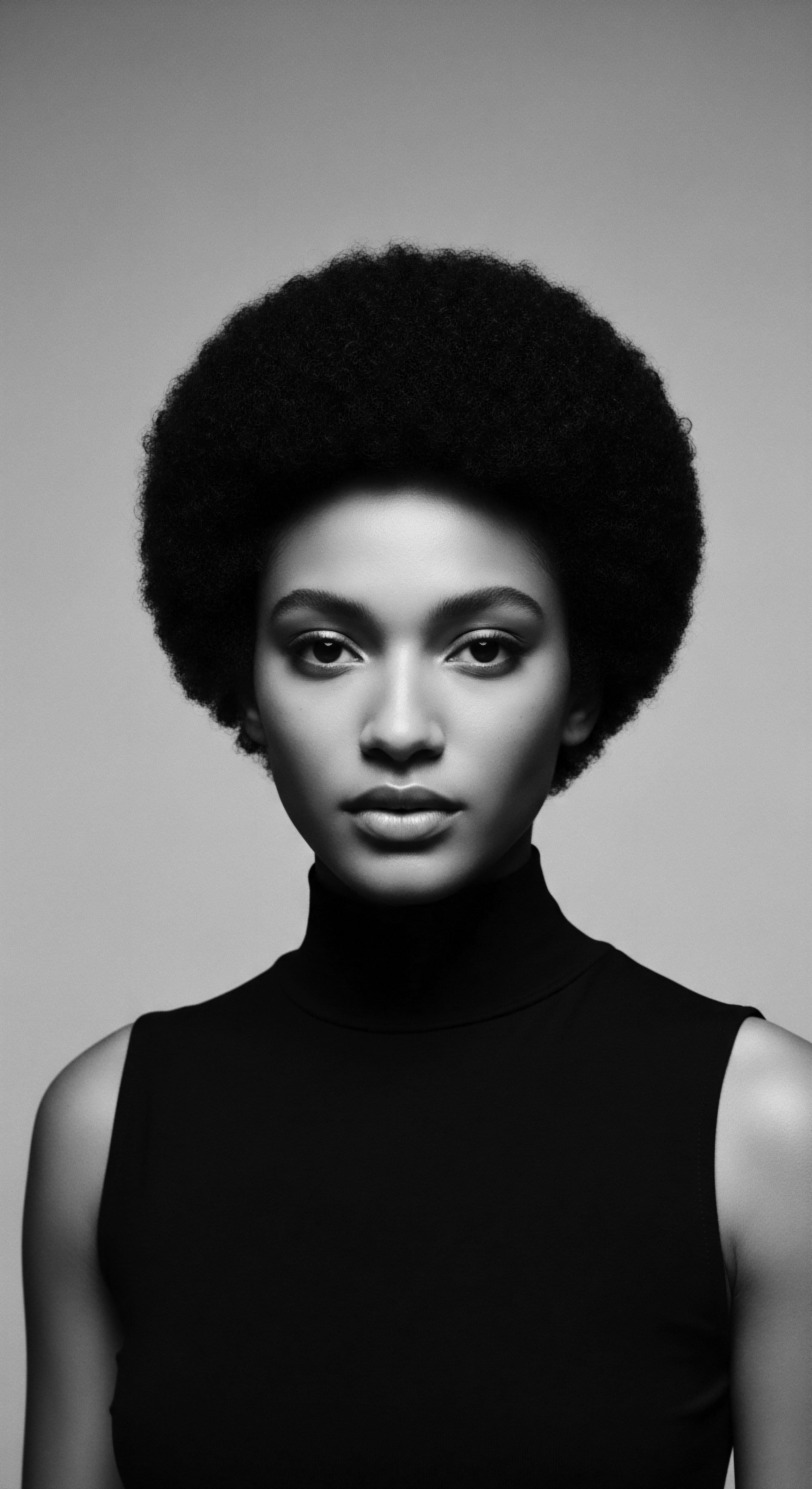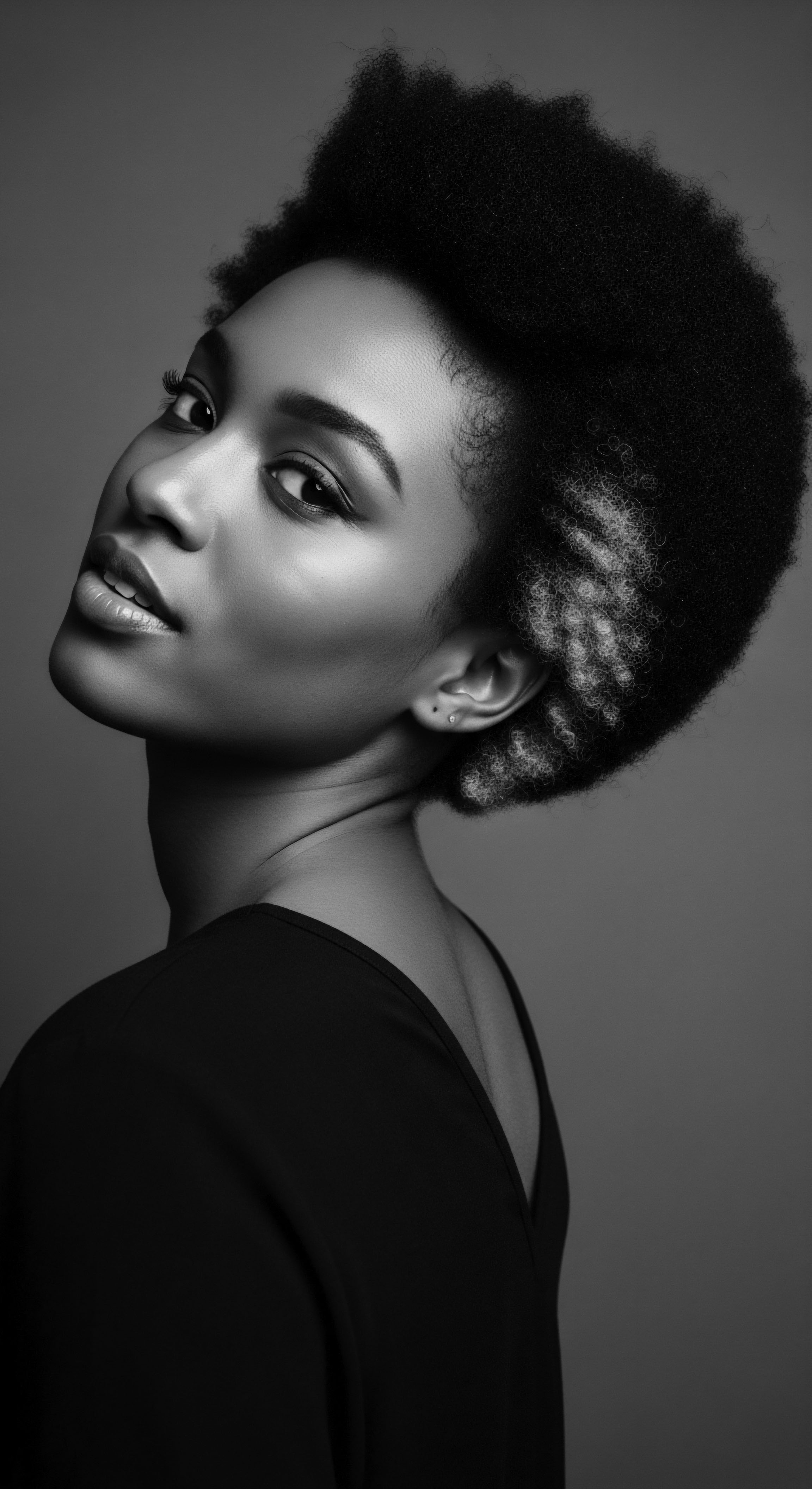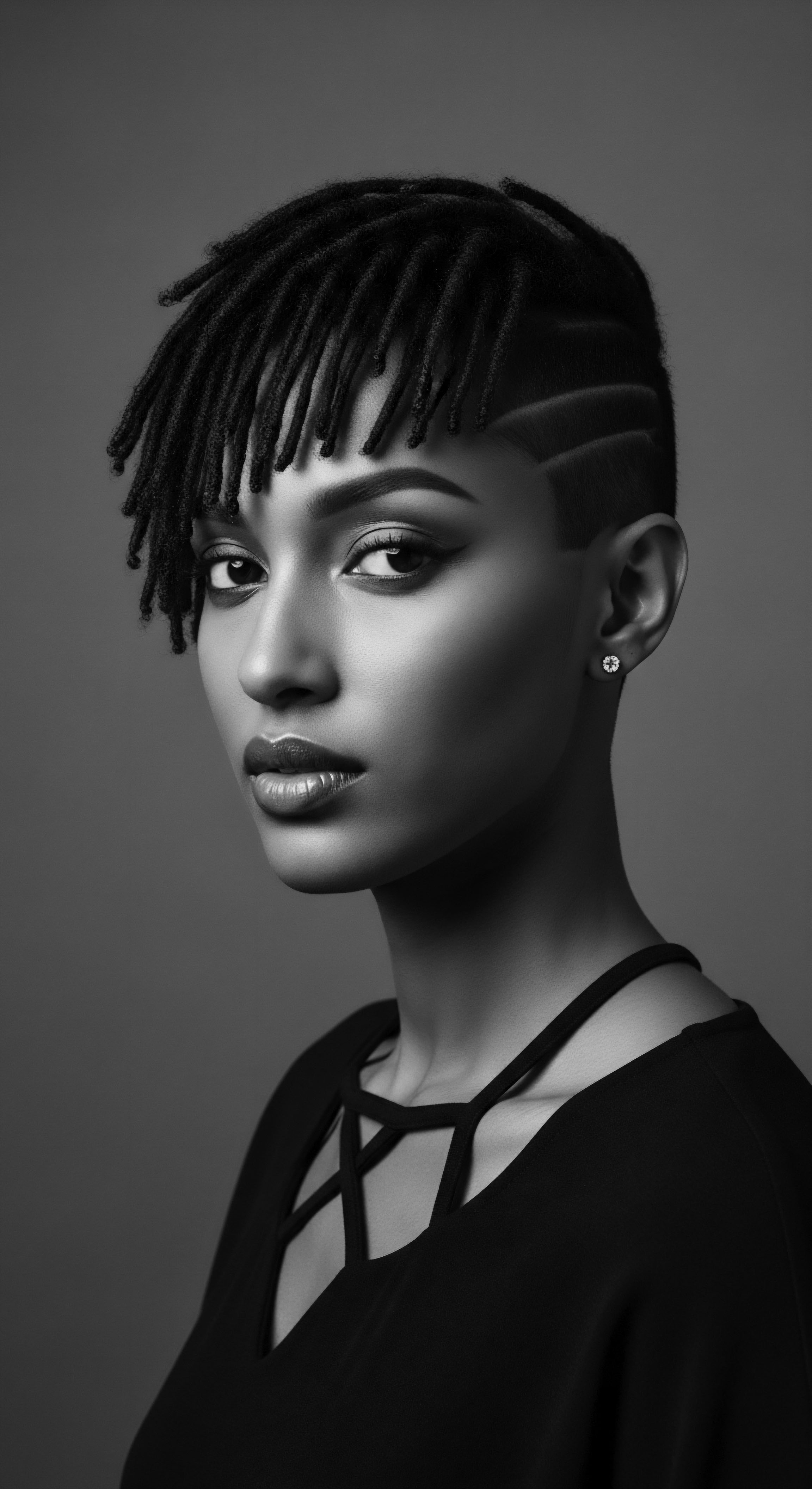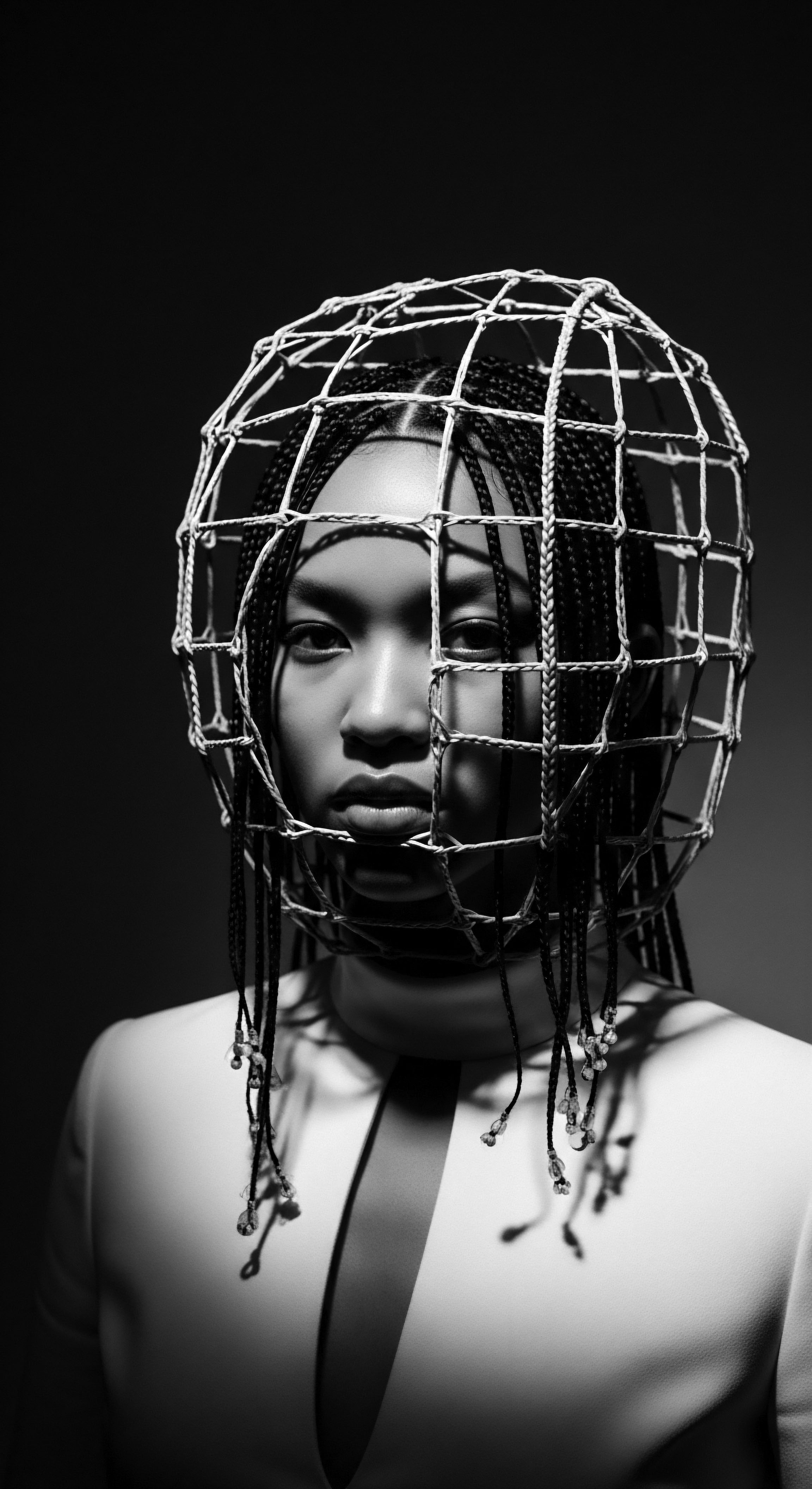
Roots
In the quiet curl of a single strand, a vast story resides. It whispers of sun-drenched savannas, of ancestral hands braiding tales of lineage and community, of journeys across vast waters, and the enduring spirit that clings to every coil and kink. This exploration of how textured hair’s physical make-up lends itself to damage is not a sterile scientific inquiry. It is a pilgrimage into the very heart of what it means to carry this crowning glory, a reverent study of the inheritance woven into every molecule.
Our hair is a living archive, holding memory, resilience, and the subtle vulnerabilities that shape its care. To truly comprehend why certain textures face particular challenges, one must first listen to the echoes from the source, from the very biology that sets it apart, and from the historical currents that have shaped its treatment through generations.

Anatomy’s Ancient Whisperings
Each strand of textured hair, whether a broad wave or a tightly coiled spiral, springs from a follicle unlike its straight counterpart. These follicles, often oval or kidney-shaped, dictate the hair’s helical growth pattern, creating a strand that is not uniformly round but elliptically flattened. This distinct shape, a biological marvel, contributes to the very character of textured hair. Consider the way a ribbon, when twisted, forms weak points along its length; similarly, the bends and turns in a textured hair fiber inherently create areas of reduced structural integrity.
These points, where the curl pattern changes direction, represent sites where the outer protective layer, the cuticle, can be more susceptible to lifting or fracturing. The cortical cells, which give hair its strength and elasticity, are distributed unevenly within these curves, contributing to differential stress points. This microscopic architecture, a testament to adaptation and diversity, also means textured hair often presents with a naturally raised cuticle, rendering it more porous and less able to retain moisture within its core. This inherent openness allows vital hydration to escape, leaving the strand feeling dry and more prone to breakage when confronted with environmental stressors or mechanical manipulation.

Classifying Coils And Cultural Currents
The language we use to describe textured hair—the familiar numbers and letters like 3C or 4A—is a modern attempt to categorize its varied forms. Yet, this classification system, while useful for product selection today, scarcely touches the surface of the descriptors and values our ancestors placed upon their hair. Traditional African societies often recognized hair by its patterns, yes, but more importantly, by its social implications, its adornments, and the communal rituals surrounding its care. Hair was a living symbol of status, age, marital state, ethnic identity, and spiritual connection.
The way hair was tended, braided, or coiffed was a language of its own, far removed from mere texture typing. The historical context of hair classification is not neutral; colonial influences, unfortunately, imposed Eurocentric beauty ideals, leading to the denigration of natural textured hair and the widespread adoption of methods to alter its appearance, often with damaging consequences. This historical shift is deeply entwined with how perceptions of damage have been shaped.
The intrinsic helical form of textured hair, a biological inheritance, creates localized zones of reduced strength, making it uniquely vulnerable to external forces.
The journey of nomenclature itself speaks volumes. Terms that once simply described hair patterns became burdened with societal judgments, reflecting a painful history of forced assimilation and the devaluation of Black aesthetics. The call to return to natural hair, a profound movement of affirmation, is a reclamation of this heritage, a defiant embrace of the hair’s inherent structure as beautiful and powerful, rather than a flaw to be corrected. It speaks to a conscious choice to understand and work with the hair’s natural inclinations, acknowledging its vulnerabilities but celebrating its strength.
Consider the role of the Follicle Shape in determining curl pattern. A round follicle produces straight hair, while an increasingly oval or asymmetrical follicle results in wavy, curly, or tightly coiled patterns. This asymmetry continues along the length of the hair fiber, influencing not only its shape but also how light reflects from its surface and how easily moisture escapes.
The tight curves mean less natural oil, or sebum, from the scalp travels down the hair shaft, contributing to dryness that is a precursor to breakage. The very twists and turns, while defining its character, also make it prone to tangling and knotting, requiring gentle handling to prevent further damage during detangling.

Ancestral Wisdom and Modern Science
When we peer into the cellular architecture of textured hair, we notice particular characteristics that render it more susceptible to damage. The outermost layer, the Cuticle, composed of overlapping scales that protect the inner cortex, is often more lifted or less tightly sealed in textured hair than in straight hair. This open structure is a double-edged sword ❉ it allows for rapid absorption of water, but also quick loss of it.
This contributes to the sensation of dryness, a persistent concern for many with textured hair. Furthermore, some studies indicate that afro-textured hair may possess fewer cuticle layers, leaving its internal structures with less inherent protection.
| Hair Type Straight Hair |
| Follicle Shape Round |
| Cuticle Characteristics Generally flat, tightly sealed layers |
| Damage Vulnerability Less prone to mechanical breakage; higher risk of chemical damage due to direct access to cortex. |
| Hair Type Wavy Hair |
| Follicle Shape Slightly oval |
| Cuticle Characteristics Can be slightly raised, some moisture loss |
| Damage Vulnerability Moderate risk of damage from styling; can experience dryness. |
| Hair Type Curly Hair |
| Follicle Shape Oval to flattened oval |
| Cuticle Characteristics More raised, prone to lifting at curves |
| Damage Vulnerability Increased risk of dryness and breakage at points of curvature. |
| Hair Type Coily Hair |
| Follicle Shape Flattened elliptical/kidney-shaped |
| Cuticle Characteristics Highly raised, potentially fewer layers, high porosity |
| Damage Vulnerability Most vulnerable to dryness, breakage, and tangling due to numerous points of weakness and rapid moisture loss. |
| Hair Type The inherent differences in hair structure contribute to distinct damage profiles, emphasizing the need for care tailored to each hair type. |
The journey of a hair strand from scalp to tip is a cycle of growth, rest, and release. For textured hair, this cycle is also influenced by historical and environmental factors. In pre-colonial Africa, hair care was a daily or weekly communal ritual, involving natural oils, butters, and practices that minimized friction and maximized hydration. This ancestral knowledge intuitively countered some of the inherent structural vulnerabilities.
For instance, the traditional use of Chebe powder among women in Chad, applied as a paste to hair, helps to reduce breakage and retain length. This practice, passed down through generations, underscores an understanding of hair’s fragility and the need for protective measures. (Premium Beauty News, 2024) The forced disruption of these practices during the transatlantic slave trade had a profound impact. Stripped of their tools, traditional ingredients, and the very time for these meticulous rituals, the hair of enslaved Africans often became matted and severely compromised. This historical trauma laid a groundwork for altered hair care practices and a changed relationship with textured hair, often prioritizing conformity over health, setting the stage for future damage.

Ritual
The hands that style textured hair, whether they are those of an ancient African elder, a community matriarch, or a contemporary stylist, engage in a dialogue with its inherent structure. These interactions, whether purposeful or unwitting, play a defining role in whether the hair flourishes or succumbs to damage. From ancestral patterns that held communal significance to modern expressions of individuality, the rituals of styling are deeply intertwined with the hair’s well-being. Understanding how historical styling practices and current techniques interact with the physical properties of textured hair is essential for preserving its health and integrity, bridging the wisdom of the past with the knowledge of the present.

Protecting Through Ancestral Styles
Long before commercial products lined shelves, communities across Africa developed sophisticated styling techniques that served dual purposes ❉ aesthetic adornment and practical protection. Styles such as braids, twists, and cornrows were not merely decorative; they were ingenious methods of safeguarding the hair from environmental stressors and reducing daily manipulation. These protective styles, often embellished with beads, shells, or cowrie shells, kept hair gathered, minimized friction against clothing or rough surfaces, and locked in moisture. The careful sectioning and gentle tension applied in these ancestral practices were a testament to a deep, intuitive understanding of hair’s vulnerability at its bends and turns.
When executed with care, these styles allowed the hair to rest, promoting length retention and minimizing breakage. These traditional methods, passed down through generations, remain cornerstones of healthy textured hair care today, their efficacy now supported by modern scientific understanding of mechanical stress and cuticle preservation.
The choice of styling tools has likewise evolved, yet the principles of gentle handling remain constant. Ancestral tools often included wide-toothed combs crafted from wood or bone, designed to detangle without excessive pulling. Natural fibers and animal hair were used to create brushes that smoothed the cuticle without causing undue friction.
The spirit of these tools, to respect the hair’s coiled nature, contrasts sharply with the introduction of harsh implements and processes during periods of forced assimilation, which prioritized straightening over preservation. This historical shift saw textured hair subjected to extreme heat and chemicals, practices that directly countered its structural needs and led to widespread damage.
Among the techniques practiced since antiquity, we find:
- Braids ❉ Various forms, from intricate cornrows to robust box braids, which protect strands from environmental exposure and mechanical friction.
- Twists ❉ Two-strand or three-strand twists that minimize handling and help retain moisture.
- Coil Sets ❉ Achieved by finger coiling or using small rods, setting the hair in its natural spiral to minimize tangling.
These practices were not just about appearance; they were about hair maintenance, a vital part of community life and personal identity. The deliberate, often time-intensive nature of these rituals underscored the profound respect for hair as a living extension of self and heritage.
Styling practices, whether ancient or modern, exert profound influence on textured hair’s vulnerability, underscoring the enduring wisdom found in protective methods.

Modern Methods and Their Consequences
The twentieth century brought profound shifts in hair care, particularly for Black women. Chemical relaxers, designed to permanently straighten textured hair, became widely adopted, often marketed as a means to conformity and professional acceptance. The historical context here is critical ❉ amidst prevailing Eurocentric beauty standards, chemically straightened hair was often seen as a prerequisite for social mobility and acceptance in white-dominated spaces. This widespread practice, while offering a semblance of ease and conformity, introduced a new dimension of damage.
Chemical relaxers operate by breaking the disulfide bonds within the hair’s cortex, permanently altering its natural structure. This process, by its very nature, weakens the hair fiber, making it extremely fragile and prone to breakage, particularly at the root where new growth meets treated hair. The repeated application of these chemicals over decades has had a cumulative effect on the health of textured hair and, indeed, on the health of Black women themselves.
A disturbing consequence of this historical adoption of chemical hair processing comes to light in epidemiological studies. The Black Women’s Health Study (BWHS) at Boston University, a comprehensive investigation following nearly 59,000 self-identified African American women for over two decades, offers sobering data. Their research indicates that frequent, long-term use of lye-based hair relaxers is connected to a heightened risk of certain health conditions. Specifically, women who used hair relaxers more than twice a year or for over five years exhibited a 50% increase in uterine cancer risk.
This specific historical example powerfully illuminates how a styling practice, driven by societal pressures rooted in heritage, has direct, severe health implications, underscoring the deep, often painful, connection between hair practices and well-being within Black and mixed-race experiences. The chemicals in these products, including phthalates, parabens, and even formaldehyde-releasing agents, are considered endocrine disruptors, substances that interfere with hormonal systems, potentially contributing to these adverse health outcomes.
Beyond chemicals, heat styling poses another significant challenge. The application of high temperatures from blow dryers, flat irons, and curling tools can degrade the protein structures within the hair and lift the cuticle, leading to dryness, frizz, and breakage. Textured hair, with its already raised cuticle and tendency towards dryness, is particularly susceptible to heat-induced damage. The water within the hair shaft can boil, causing bubble deformities along the fiber, further compromising its integrity.
While modern heat protectants offer some defense, excessive or improper use of heat styling remains a leading cause of damage, often manifesting as irreversible alterations to the hair’s natural curl pattern. The pursuit of straightened hair, whether through chemical or thermal means, has a long and complex history within Black communities, often reflecting a painful dance between self-expression, societal pressure, and the cost to hair health.

Relay
The health of textured hair is not merely a matter of scientific principle; it is a relay of wisdom, a continuous passing of understanding from one generation to the next, often informed by ancestral practices and adapted to modern realities. This continuity speaks to how knowledge of hair’s structural vulnerabilities has shaped care routines across centuries, fostering a deep connection to well-being that extends beyond the physical strand. To truly safeguard textured hair from damage, we must look to this inherited knowledge, observing how it informs our contemporary methods, ingredients, and even our nightly rituals, acknowledging the ongoing interplay between biology, heritage, and informed action.

Care Regimens Echoing Ancient Principles
At the heart of preserving textured hair lies a regimen built upon consistent moisture, gentle handling, and strategic protection. These principles, far from being modern inventions, resonate with the ancestral practices that revered hair as a sacred adornment. Our forebears intuitively grasped the need for hydration in climates that could otherwise parch strands. They relied on natural emollients and humectants from their surroundings to keep hair supple.
Think of the historical reliance on shea butter, coconut oil, and castor oil across various African communities. These ingredients, rich in fatty acids and vitamins, served to seal moisture into the hair fiber and provide a protective barrier against environmental assault. Modern science now validates the efficacy of these traditional components, confirming their role in supporting cuticle health and reducing protein loss. The application methods, too, were steeped in care, often involving slow, deliberate massaging that stimulated the scalp and distributed natural oils.
Problem-solving for textured hair, then and now, often circles back to managing dryness and breakage. Ancestral wisdom understood that dryness predisposed hair to snapping. Consequently, traditional practices emphasized deep conditioning treatments using plant-based concoctions and the practice of protective styling to minimize friction.
The hair’s natural inclination to tangle, a direct result of its coiled form, was met with patient detangling methods, often involving wide-toothed tools and ample lubrication to preserve the delicate cuticle. This patient approach, passed down through the generations, directly addresses the hair’s inherent structural fragility at its many turns.

Nighttime Sanctuaries And Bonnet Wisdom
One of the most powerful and perhaps least celebrated aspects of modern textured hair care, deeply rooted in heritage, is the nighttime ritual. The use of bonnets, scarves, and satin pillowcases is not merely a preference; it is a strategic defense against mechanical damage. Historically, African women often wrapped their hair, not just for aesthetic reasons or modesty, but to protect it from friction against sleeping surfaces and environmental elements. This practice, often seen in West African traditions, served to preserve intricate hairstyles and maintain hair health, demonstrating an early understanding of minimizing external stressors.
During sleep, hair can rub against rough fabrics like cotton, leading to friction that lifts the cuticle, causing frizz, dryness, and ultimately, breakage. Satin or silk, with their smooth surfaces, reduce this friction significantly, allowing the cuticle to remain flat and sealed, thereby retaining moisture and minimizing tangles. This simple yet profound practice is a direct relay of ancestral knowledge, adapted with modern materials, to combat the very specific structural vulnerabilities of textured hair.
How does minimizing friction during sleep preserve textured hair’s structural integrity?
The nightly protection offered by satin or silk fabrics directly counteracts the mechanical stress that textured hair, with its inherently raised cuticle and numerous points of curvature, is particularly vulnerable to. When hair rubs against coarse materials, the overlapping cuticle scales are abraded and lifted. This compromise to the cuticle layer exposes the inner cortex, allowing moisture to escape and making the hair shaft more susceptible to breakage. By providing a smooth, low-friction surface, satin and silk help maintain the cuticle’s integrity, keeping it flat and sealed.
This not only preserves the hair’s moisture balance but also significantly reduces tangling and knotting, which are major contributors to breakage in coiled and kinky textures. The continuity of this practice, from historical headwraps to contemporary bonnets, underscores a timeless understanding of how environmental interactions influence hair health, passed down through generations.
The holistic approach to textured hair health, drawing from ancestral wellness philosophies, views hair as an extension of overall well-being. This perspective encourages consideration of diet, stress levels, and even community support as elements that impact hair’s vitality. In many traditional African societies, communal hair grooming sessions were not just about aesthetics; they were spaces for bonding, storytelling, and sharing knowledge.
This communal aspect fostered a supportive environment where hair care was understood as a collective responsibility, contributing to both individual and collective resilience. This view contrasts with a more individualized, product-driven approach that often overlooks the broader influences on hair health.
A list of ingredients revered in ancestral practices and now supported by modern science for textured hair health:
- Shea Butter ❉ A rich emollient, traditionally used across West Africa, providing deep moisture and sealing benefits.
- Coconut Oil ❉ Valued for its ability to penetrate the hair shaft and reduce protein loss, used for centuries in various tropical regions.
- Castor Oil ❉ A viscous oil, historically used for its perceived hair growth benefits and as a scalp conditioner in many cultures.
- Chebe Powder ❉ An ancestral Chadian ingredient, ground from Croton gratissimus seeds, used in paste form to promote length retention by reducing breakage.
- Aloe Vera ❉ Used for its soothing and hydrating properties, a traditional remedy for scalp health in many Indigenous and African communities.
Understanding hair porosity is another aspect where modern science intersects with historical observation. Highly porous hair, often characteristic of textured types, quickly absorbs and loses moisture. Ancestral practices instinctively addressed this by layering oils and butters, effectively creating a moisture seal. This knowledge, relayed through generations, empowers us to select ingredients and practices that honor the hair’s inherent characteristics, creating a responsive and protective regimen.

Reflection
The journey through the very structure of textured hair, examining its unique vulnerabilities to damage, leads us back to a singular, profound realization ❉ our hair is more than a biological phenomenon. It is a living story, a testament to enduring spirit, passed down from ancestral hands. Every coil, every strand, holds the echoes of pre-colonial practices, the trials of forced assimilation, and the triumphs of reclamation. The scientific understanding of its elliptical shape, its unique cuticle patterns, and its natural tendency towards dryness does not diminish its beauty; instead, it deepens our appreciation for its resilience and the ingenuity of the care rituals developed over centuries.
Our hair, indeed, possesses a soul, an intrinsic connection to heritage that guides its growth, its styling, and its preservation. It is a living library of wisdom, a constant invitation to honor the past while shaping a vibrant future. In truly seeing and caring for textured hair, we not only address its physical needs but also affirm a legacy of strength, adaptation, and profound cultural continuity.

References
- Bertrand, K.A. et al. “Hair relaxer use and risk of uterine cancer in the Black Women’s Health Study.” Environmental Research, vol. 239, Part 1, 2023.
- Draelos, Z.D. “Black individuals require special products for hair care.” Cosmetic Dermatology, vol. 6, 1993, pp. 19-20.
- McMichael, A.J. “Ethnic hair update ❉ Past and present.” Journal of the American Academy of Dermatology, vol. 48, 2003, pp. S127-S133.
- Gathers, A.K. and Patel, N.N. “Hair Care Practices in African-American Patients.” Seminars in Cutaneous Medicine and Surgery, vol. 28, 2009, pp. 103-108.
- Johnson, D. “The Anatomy of a Curl.” Tame It Curl Haus, 2024.
- Holy Curls. “How does curly, textured hair become so damaged?” Holy Curls, 2021.
- Monpure. “The Signs And Science Of Damaged Hair.” Monpure, 2022.
- K18 Hair. “Science Class 14 ❉ Different types of damage.” K18 Hair.
- Society for Pediatric Dermatology. “Curly/coily hair care.”
- Revan, D. “Hair, History, and Healthcare ❉ The Significance of Black Hairstyles for Dermatologists.” VisualDx, 2024.
- Niyoyita, A. de G. “Ancestral hair-paste ritual gains new life in Chad.” Premium Beauty News, 2024.
- Caffrey, C. “Afro-textured hair.” EBSCO Research Starters, 2023.
- Bebrų Kosmetika. “The Power of Hair in African Folklore ❉ Rituals and Traditions.” Bebrų Kosmetika, 2024.
